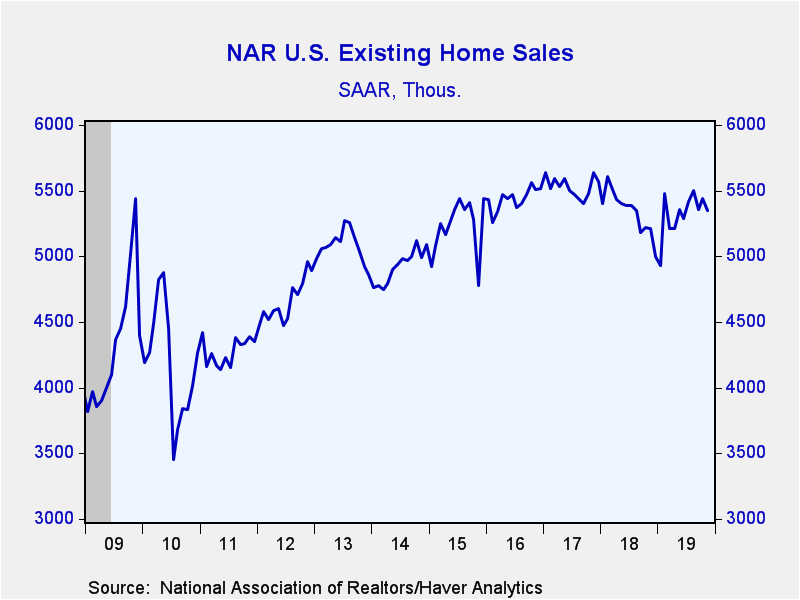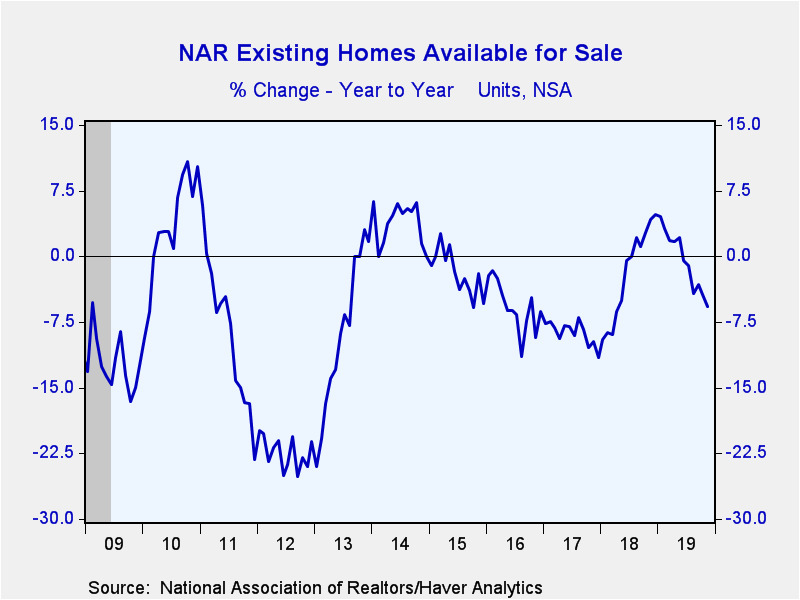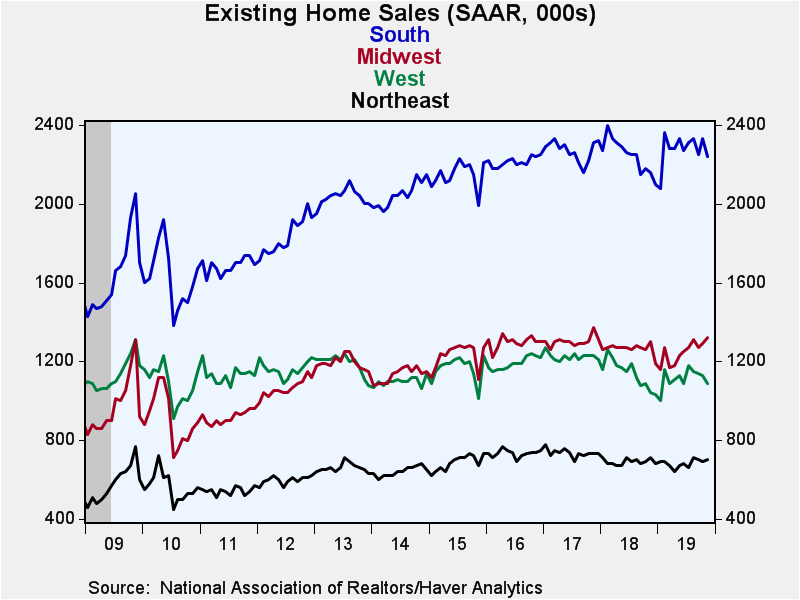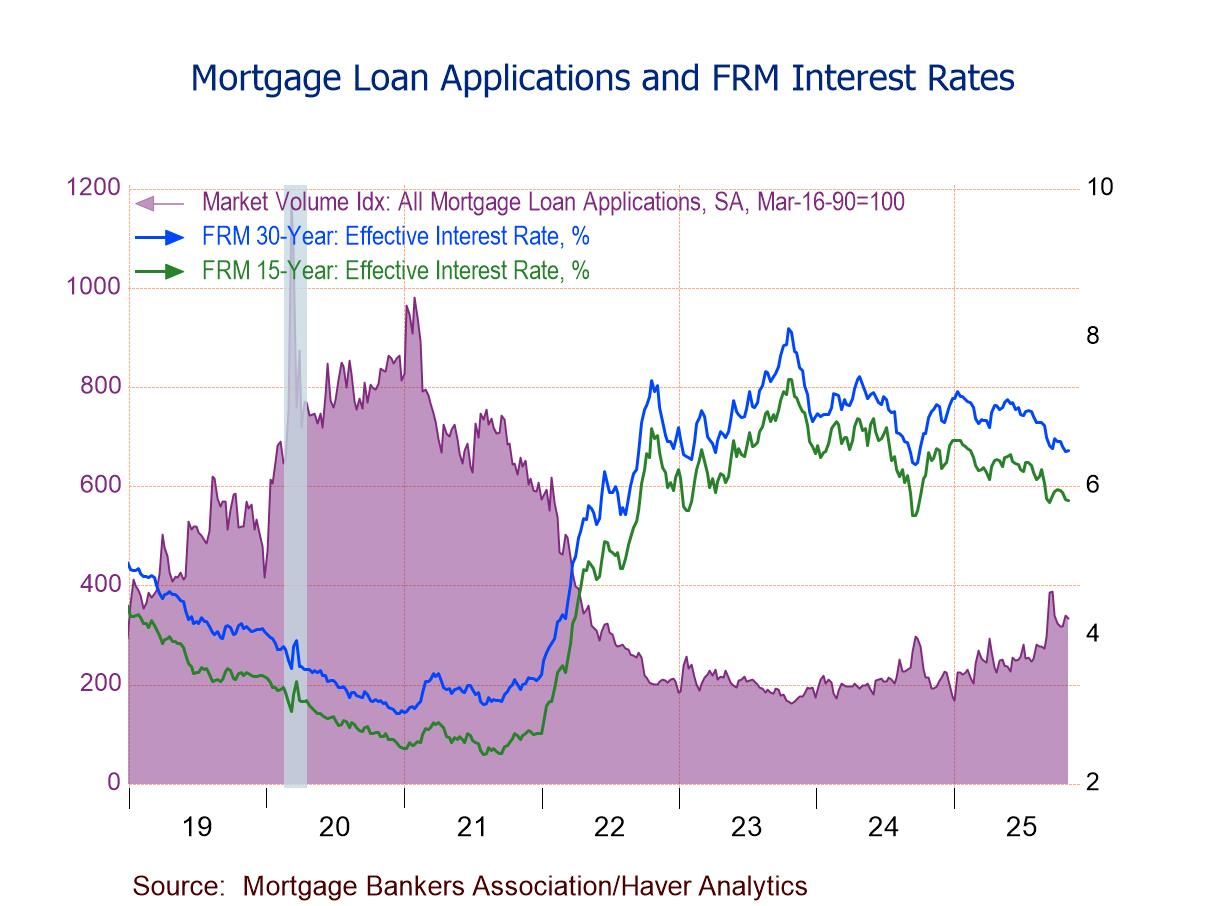 Global| Dec 19 2019
Global| Dec 19 2019U.S. Existing Home Sales Weaken as Availability Declines
by:Tom Moeller
|in:Economy in Brief
Summary
The National Association of Realtors (NAR) reported that sales of existing homes during November fell 1.7% (+2.7% y/y) to 5.350 million (SAAR) after rising to 5.440 million in October, revised from 5.460 million. It was the lowest [...]
The National Association of Realtors (NAR) reported that sales of existing homes during November fell 1.7% (+2.7% y/y) to 5.350 million (SAAR) after rising to 5.440 million in October, revised from 5.460 million. It was the lowest level of sales since June. The Action Economics Forecast Survey expected November sales of 5.44 million.
The number of homes on the market declined 5.7% y/y to the lowest level in nine months, although the number typically will decline this time of year. The months' supply of homes on the market decreased m/m to 3.7 from 4.0 twelve months ago.
The median price of all existing homes sold edged 0.1% higher (5.4% y/y) to $271,300. The average sales price rose 0.3% (4.0% y/y) last month to $308,000. These price data are not seasonally adjusted.
Existing home sales were mixed around the country in November. In the Midwest, they increased 2.3% (1.5% y/y) to 1.320 million after rising 1.6% in October. Sales in the Northeast gained 1.4% (-1.7% y/y) to 700,000 and reversed the prior month's decline. Month-to-month declines occurred elsewhere in the country. Sales in the South declined 3.9% (+3.7% y/y) to 2.240 million after a 3.6% gain. In the West, sales fell 3.5% (+4.8% y/y) to 1.090 million and were off for the fifth month in the last six.
Sales of existing single-family homes declined 1.2% (+3.5% y/y) to 4.790 million units after rising 1.7% in October. Sales of condos and co-ops fell 5.1% to 560,000 units (-3.4% y/y) after holding steady in October.
The data on existing home sales, prices and affordability are compiled by the National Association of Realtors and can be found in Haver's USECON database. The regional price, affordability and inventory data are available in the REALTOR database. The expectations figure is from the Action Economics Forecast Survey, reported in the AS1REPNA database.
| Existing Home Sales (SAAR, 000s) | Nov | Oct | Sep | Nov Y/Y % | 2018 | 2017 | 2016 |
|---|---|---|---|---|---|---|---|
| Total Sales | 5,350 | 5,440 | 5,360 | 2.7 | 5,341 | 5,531 | 5,437 |
| Northeast | 700 | 690 | 700 | -1.7 | 689 | 735 | 733 |
| Midwest | 1,320 | 1,290 | 1,270 | 1.5 | 1,265 | 1,301 | 1,297 |
| South | 2,240 | 2,330 | 2,250 | 3.7 | 2,246 | 2,270 | 2,215 |
| West | 1,090 | 1,130 | 1,140 | 4.8 | 1,141 | 1,225 | 1,192 |
| Single-Family Sales | 4,790 | 4,850 | 4,770 | 3.5 | 4,742 | 4,907 | 4,822 |
| Median Price Total ($, NSA) | 271,300 | 271,000 | 271,500 | 5.4 | 257,267 | 245,950 | 232,067 |
Tom Moeller
AuthorMore in Author Profile »Prior to joining Haver Analytics in 2000, Mr. Moeller worked as the Economist at Chancellor Capital Management from 1985 to 1999. There, he developed comprehensive economic forecasts and interpreted economic data for equity and fixed income portfolio managers. Also at Chancellor, Mr. Moeller worked as an equity analyst and was responsible for researching and rating companies in the economically sensitive automobile and housing industries for investment in Chancellor’s equity portfolio. Prior to joining Chancellor, Mr. Moeller was an Economist at Citibank from 1979 to 1984. He also analyzed pricing behavior in the metals industry for the Council on Wage and Price Stability in Washington, D.C. In 1999, Mr. Moeller received the award for most accurate forecast from the Forecasters' Club of New York. From 1990 to 1992 he was President of the New York Association for Business Economists. Mr. Moeller earned an M.B.A. in Finance from Fordham University, where he graduated in 1987. He holds a Bachelor of Arts in Economics from George Washington University.










